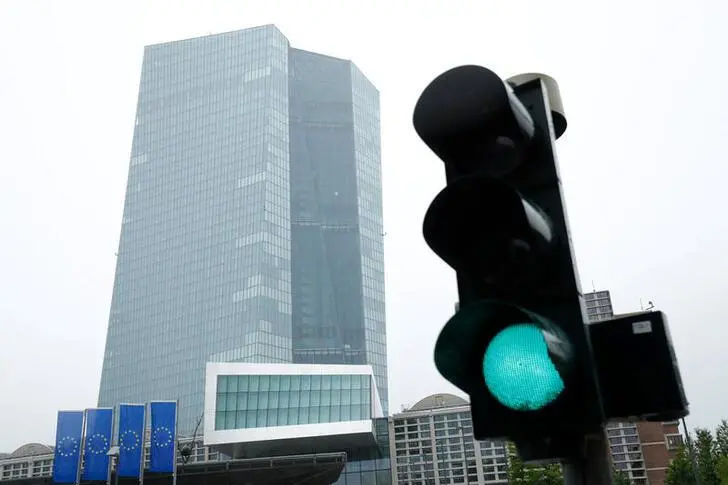PHOTO
(The author is editor-at-large for finance and markets at Reuters News. Any views expressed here are his own)
LONDON- It's hard playing a worldwide reflation trade when consumer prices have yet to stop falling.
Later this week the euro zone is set to record the joint longest period of headline monthly deflation since the single currency was introduced - joining Japan and Switzerland in a pandemic-driven bout of falling prices that will pressure the European Central Bank to keep its foot to the floor on monetary policy even as markets bet on recovery.
If consensus forecasts prove correct, the pace of euro zone deflation should have slowed a notch to 0.2% last month - even as aggregate prices remained negative for the fifth month in a row and match a 5-month slough in 2009. Core inflation rates, excluding food and energy prices, will likely cling to positive territory, even though the meagre 0.4% rate expected remains the lowest on record.
Japan and Switzerland have headline and core inflation rates running even more negative than the euro zone.
And the new year hardly bodes well for a pickup in prices, with COVID-19 raging, more severe economic lockdowns and potentially vaccine-resistant variants emerging.
Oil prices have more than doubled from the depths of the pandemic shock 9 months ago - even if crude remains down more than 20% on this time last year. And the rebound in world food prices puts them about 3% above 12 months ago and near 6-year highs.
But this is hardly the stuff of runaway inflation that would have us investing in wheelbarrows to carry the cash.
The ECB's survey of professional forecasters in the final quarter of last year assigned more than a 70% probability that inflation remains at or below the ECB's near 2% target over the next 5 years - even though it also ascribed only a 3% chance of deflation persisting over that timeline.
German 10-year inflation expectations, implied by inflation protected government bonds - so-called breakevens - are less than 1%.
But many in financial markets remain convinced that rising global inflation will yet be a legacy of this crisis - even if it largely relies on the United States for evidence and is the flipside of overwhelmingly bearish views on the U.S. dollar.
U.S. 10-year inflation breakevens rose above 2% on Monday for the first time in two years as Fed money printing outpaces other central banks and the prospects of a mega fiscal splurge was rekindled by growing chances the Democrats can take both houses of Congress after this week's Georgia Senate runoffs.
'UNDER-APPRECIATED'
Giant asset manager BlackRock reckons the road ahead will see central banks determined to cap nominal government borrowing rates as growth and inflation eventually rebound. Real, or inflation-adjusted, rates will therefore sink even further and provide a bigger boost to risky assets than during prior inflationary periods.
"Medium-term inflation risks look under-appreciated," it told clients.
Morgan Stanley's global economist Chetan Ahya said the bank's optimistic take on the rebound meant inflation would move significantly higher too and he was still convinced the Fed would hit its 2% target by year-end and allow it to overshoot right through 2022.
Citi's Ebrahim Rahbari is also comfortable that the market bias for reflation from late last year will persist despite periodic nerves surrounding the virus and related restrictions.
"We expect cross-asset reflation trades will continue to work this year, as positioning remains modest, while real rates remain low, money on the sidelines ample and macro stimulus forceful," he wrote.
For many, this "inflation scare" is merely a function of market positioning and hinged on an assumption central banks will tolerate more inflation than in the past. But that still assumes it will re-emerge and remains wishful thinking.
Recent surges in everything from equities, breakevens, gold and even bitcoin have been put down to an inevitability last year's central bank money expansion feeds long-dormant consumer price rises. But it's hard to see that happening while cash demand remains so high amid another wave of lockdowns.
There's even less certainty that an inflation uptick would be sustainable without unlikely matching wage rises and a big disturbance to years of stable household inflation expectations.
However, the largely U.S.-centric inflation view is matched by the hugely negative U.S. dollar consensus.
As years of deflation in Japan and Switzerland indicate, price deflation and currency appreciation tend to go hand in hand - as cash hoarding is encouraged by the prospect of its real value increasing over time.
Just how negative interest rates need to go to offset that is a policy conundrum - but perceived limits to negative rates due to banking stability worries mean persistent deflation will just lift the likes of the euro, yen and franc and potentially suffocate two of the biggest economic areas in the world.
Could U.S. inflation be exported via a weaker dollar that lifts dollar-denominated global food and commodity prices Absent wage rises, pricier food and energy would just tax already strapped households and be another burn after this year's shock.
Whatever the answer, the inflation scare requires considerable faith and still seems unlikely to emerge this year.
Mike Dolan
(by Mike Dolan, Twitter: @reutersMikeD; editing by Barbara Lewis) ((mike.dolan@thomsonreuters.com; +44 207 542 8488; Reuters Messaging: mike.dolan.reuters.com@thomsonreuters.net))












